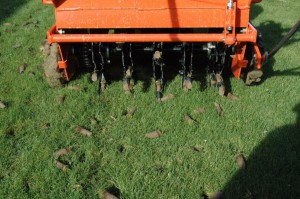Normally, my blog is dedicated to providing information to farmers and agribusinesses on crops grown around our area. However, I decided to add some lawn care information to the blog since I receive so many questions regarding lawn care. Most everyone has grass in their yard and wants it to look as lush and green as possible. Some even work hours and spend thousands of dollars trying to get their yard to look like the 13th hole at Augusta National Golf Course. At times, many people get discouraged about their lawn or receive misinformation about lawn care from an unreliable source.
Let’s discuss a few things that can really help you out in your lawn.
STOP OVER FERTILIZING CENTIPEDEGRASS!
The most widely planted and popular lawn grass in our area is Centipedegrass. It’s very low maintenance and requires very little care. I found this description of Centipedegrass from a University website: “Its popularity as a lawn grass stems from its adaptation to low fertility conditions and its low maintenance requirements. Where Centipedegrass is adapted and properly managed, it has few serious pest problems. It is particularly well adapted to the sandy, acid soils of the southeastern United States.” The article continues, “It is often called lazy man’s grass.”
Tony Bertauski, a columnist for the Post and Courier stated, “Centipede grass is like a teenager. It won’t clean out your refrigerator, or ask you to drop it off a block from the party, but it would prefer you just left it alone.” That’s the best way to describe centipede management.
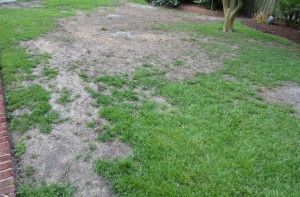
If you have centipedegrass and your goal is to have a healthy lawn you need to avoid heavy amounts of fertilizer. One pound of nitrogen per 1,000 square feet per year is ample nitrogen on most centipede lawns. On sandy soils in high rainfall areas, 2 pounds per 1,000 square feet per year may be needed. Apply 5 pounds of 12-4-8 per 1,000 square feet in early spring. If a second application is needed, apply 5 pounds of 12-4-8 per 1,000 square feet in early August. One 50 lb. bag of fertilizer is enough for 10,000 sq. ft. and 200 lbs. (4 bags) is enough for an entire acre.
Measure your yard to know the exact square footage. A one acre lot doesn’t have one acre of grass growing. Part of that acre has a house, maybe a storage shed, garden, landscape, driveway, etc., and that needs to be subtracted from the area.
When it comes to Centipede, more fertilizer is not better. The more fertilizer you over apply, the more likely you are to cause injury. It doesn’t make sense to spend money on more fertilizer just to kill your grass, does it?
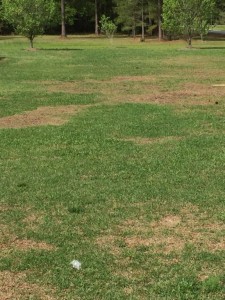
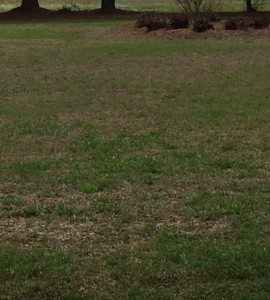
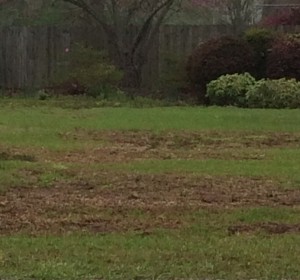
High levels of nitrogen fertilizer can also lead to disease problems. Large patch disease is encouraged by over fertilization, fertilizing too early, incorrect irrigation, and excessive thatch levels.
When should you apply fertilizer to lawns?
Don’t get in a big hurry to apply fertilizer. Our most common warm season grasses are Centipede, Bermuda, St. Augustine, and Zoysia. These varieties won’t need fertilizing until April or May. Most warm season grasses are just coming out of dormancy and they need to be completely out of dormancy to apply fertilizer. When grasses are dormant, their roots are not able to use the nutrients from fertilizers. The winter weeds in your yard will love the fertilizer that’s applied early, but your lawn won’t benefit much from it. Also, bare spots, thinning of the lawn, and delay in spring green-up may occur when lawns are forced to grow when they should be dormant.
Centipedegrass rarely needs any lime. It grows best in acidic soils and can have disease problems in high pH areas. Never apply lime on centipede without first taking a soil sample.
A soil test is always a good starting point before investing in fertilizer or lime. Contact your local University of Georgia County Extension office for soil sampling information.
Weed Control
Winter weeds are growing in most lawns around our area. It’s important to control winter weeds when they are small. At first these weeds grow slowly, but when temperatures warm up they begin to grow profusely. Large weeds are more difficult to control with herbicides than small weeds. If you haven’t already applied a herbicide for winter weeds, you can still get decent results by spraying now. Be sure to apply products that will kill winter weeds and provide pre-emergent control for summer weeds.
Atrazine herbicide for example, has both pre and post emergent activity. It will control weeds that are growing and provides control for weeds that haven’t germinated. Even if you don’t kill all the winter weeds that are currently growing, the Atrazine will prevent most summer weeds from germinating.
Follow all label instructions when mixing Atrazine. You’ll need to add another herbicide for crabgrass control. Chemicals with the active ingredient pendamethalin work great for pre-emergent grassy weed control. Mix 1 quart of surfactant per 100 gallons of spray mix. Atrazine can be used on St. Augustine, Centipede, Bermudagrass and Zoysia. If a dormant application cannot be made, wait until 3 weeks after spring greenup to apply Atrazine. Make the application before April 15. Bermudagrass must be dormant for Atrazine application to avoid injury. Only use 1 qt. per acre on Bermudagrass.
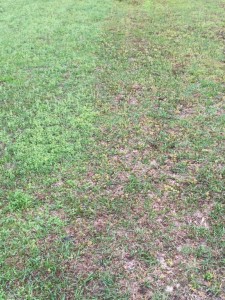
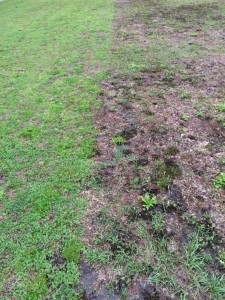
Atrazine is not the best product for controlling dandelion weeds. You can see some of the dandelions are still green in the above picture. My choice for herbicide application in yards is a tank mix of Atrazine or Simazine + Pendamethalin + Metsulfuron. The rates are 2 quarts of Atrazine and Pendamethalin per acre and .25 to .50 oz. of Metsulfuron per acre. In 6 to 8 weeks apply 2 more quarts of Pendamethalin per acre. This combination works great and you’ll see results in about three weeks. The 2 applications of Pendamethalin should control crab, goose and johnsongrass all season.
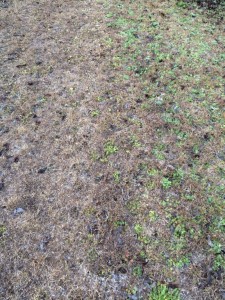
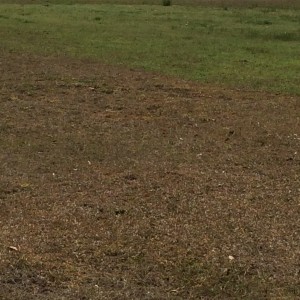
Substitute Simazine for Atrazine on Bermudagrass that is greening up to avoid injury. You can make the same substitution if you have a lot of ornamental plants and want to avoid the Atrazine damage.
Notice I didn’t mention anything about 2,4-D. 2,4-D can drift and harm ornamental plants, trees and shrubs. It also can cause injury to Centipedegrass if excessive rate are applied. If for some reason you need 2,4-D, apply the low rate on a day that isn’t windy. Never use 2,4-D on St. Augustinegrass.
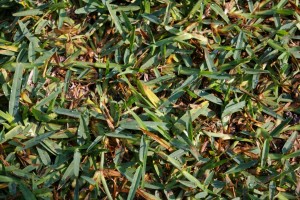
If you purchase pre mixed granular products read the label to know what the active herbicide is. A brand name product may have three different products that all contain different herbicides. Read the active ingredients section on the bottom right or left corner of the bag.
Irrigation
One of the biggest mistake people make in lawns, next to over fertilizing, is irrigating. Irrigation systems should not run every day for 30 min. This causes weak shallow root systems. The system should run long enough to apply 1 inch of water once or twice a week. Usually it takes 5 to 8 hours to apply an inch of water, but check the system using rain gauges. Irrigation should occur between 9 pm and 6:30 a.m. to avoid wetting the grass when it would normally be dry.
Thatch
If the lawn is not irrigated and fertilized correctly, thatch accumulation could create a problem. Excess thatch reduces water infiltration, creates shallow-rooted turf, and encourages insect and disease problems. If excess thatch accumulates, the lawn will feel soft and spongy. Thatch build up will cause bare spots in the yard and you could lose the entire stand of grass.
To remove thatch, a process called dethatching will be needed. You can purchase a dethatching blade for your mower at most places that sell lawn and garden equipment. Go across your lawn a couple of times with the dethatching blade to remove the thatch. Then, let the grass grow and don’t apply anymore fertilizer. Dethatching is generally recommended during spring to allow recovery before summer.
Core aerification is also an effective treatment and much less stressful to the lawn than dethatching. Aerifiers punch holes in the soil that physically remove thatch while stimulating root growth. Core aerifiers can be leased from equipment rental dealers and is usually done during the active growing season. Spike aerators don’t give the same results as the core aerators.
Mowing
Mow often enough that you never remove more than 1/3 of the leaf blade. This can usually be achieved by mowing every 7 days. Centipede should be mowed to 1.5 inches high.
Information for other grass
St. Augustine should receive four pounds of nitrogen per 1000 square feet a year. The mowing height for St. Augustine should be 2.5 to 3 inches. It is very sensitive to low mowing heights and scalping. Apply an insecticide if chinch bugs become a problem.
The more common St. Augustinegrass varieties are Bitter Blue, Floratine and Floratam. Bitter Blue has the best shade tolerance but is sensitive to chinch bugs and St. Augustine Decline Virus (SADV). Floratine has the finest leaf texture but is also susceptible to chinch bugs and SADV. Floratam has the coarsest leaf texture, is resistant to chinch bug and SADV, but is not as shade tolerant as the others.
Bermudagrass should receive 4 lbs. of nitrogen per 1,000 square feet a year.
What about Athletic Fields?
Some people say they base their lawn decisions on what area athletic fields are doing. Unfortunately, some (not all) of those are not always managed properly. Athletic fields should be managed very similarly to yards. There are some different things that have to be done, but the basic agronomic care and management should be the same. The information below came directly from the UGA publication, “Athletic Field Management” by Dr. Gil Landry.
“Apply enough water to soak the soil to a depth of at least 6 to 8 inches. On medium-textured soils, this usually means applying about 1 inch of water per week during the summer. Light, frequent irrigations encourage shallow, weak root systems and thatch accumulation.”
“The best time of day to irrigate is before sunrise because there is less wind and lower temperatures, thus less water loss to evaporation. Night irrigation is more efficient than during the day. Irrigating after dew develops or before the morning dew dries off does not increase disease problems. Irrigating 24 to 48 hours before major field use will help reduce soil compaction.”
Now, how many of you have passed by an athletic field and noticed sprinklers running in the middle of the day every single day? My point is, just because you see someone doing something doesn’t make it correct. Manage your lawn correctly based on UGA recommendations and don’t worry about what others are doing.
Conclusion
I often hear people say, “I wanted my yard a dark green color.” Centipedegrass is NOT supposed to be a dark green color. Centipedegrass is a natural pale green color. If centipede is dark green you’ve applied to much fertilizer and will see the grass decline eventually. If your goal is for the lawn to look like a golf course you need to plant a hybrid Bermudagrass. If you continue watering improperly and applying to much fertilizer you’ll get the chance to replant the yard very soon. By irrigating and fertilizing properly, you’ll avoid problems in the yard.
